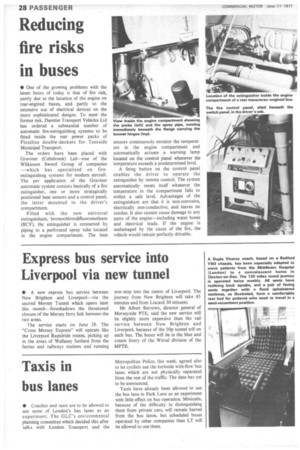Reducing fire risks in buses
Page 30

If you've noticed an error in this article please click here to report it so we can fix it.
• One of the growing problems with the latest buses of today is that of fire risk, partly due to the location of the engine on rear-engined buses, and partly to the extensive use of electrical devices on the more sophisticated designs. To meet the former risk, Daimler Transport Vehicles Ltd has ordered a substantial number of automatic fire-extinguishing systems to be fitted inside the rear power packs of Fleetline double-deckers for Teesside Municipal Transport.
The orders have been placed with Graviner (Colnbrook) Ltd—one of the Wilkinson Sword Group of companies --which has specialized on fireextinguishing systems for modern aircraft. The psv application of the Graviner automatic system consists basically of a fire extinguisher, one or more strategically positioned heat sensors and a control panel. the latter mounted in the driver's compartment.
Filled with the new universal extinguishant, bromochlorodifluoromethane (BCF), the extinguisher is connected by piping to a perforated spray tube located in the engine compartment. The heat sensors continuously monitor the temperature in the engine compartment and automatically actuate a warning lamp located on the control panel whenever the temperature exceeds a predetermined level.
A firing button on the control panel enables the driver to operate the extinguisher by remote control. The system automatically resets itself whenever the temperature in the compartment falls to within a safe level. Advantages of the extinguishant are that it is non-corrosive, electrically non-conductive, and leaves no residue. It also cannot cause damage to any parts of the engine—including water hoses and electrical leads. If the engine is undamaged by the cause of the fire, the vehicle would remain perfectly drivable.


































































































































































